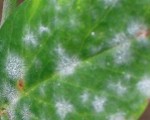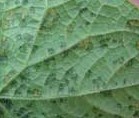
Mildews that cause diseases in plants are of two different types, powdery and downy. Although they have similar names they are distinctly different and have different symptoms and control measures. Powdery mildews are true fungi while downy mildews are entirely different organisms that is related to algae. If you have mildew problems in your garden the first step in solving it is to identify which kind of mildew you have and then take steps to prevent and control it.

Powdery mildew is the most common type of mildew and can be found on most ornamental plants including phlox, monarda, azaleas, roses, lilac, privet, dogwood, crab apple, grape, squash, and turf grass. There are many different kinds of powdery mildew and they are host specific so that the organism that cause mildew on grapes, for example, can not cause mildew on lilac. Powdery mildew can usually be recognized by the white cobweb like growth of the mycelium on the upper surface of the leaf that sometimes occurs on the underside of leaves as well as on stems, buds, flowers, and young fruit. Leaves that are infected often curl, become distorted and brown, and drop off prematurely. Infected buds fail to open. Although the effects of powdery are unsightly and weaken the plant the mildew rarely kills it. The fungus takes its nourishment from the top layer of cells and does not invade the tissues below.

Downy mildew is less common but can be very damaging to plants. It effects a wide variety of plants including members of the mint family, roses, butterfly bush, coreopsis, pansy, snapdragon, viburnum, and cucumbers. The symptoms vary according to the host plant but usually can be seen as yellow, light green, or dark spots on the upper surfaces of the leaves. As the disease progresses the leaves turn brown and drop from the plant. In addition, fluffy gray to brownish masses may appear on the underside of the leaf in the areas of discoloration. Downy mildews penetrate the leaf tissue for nourishment and hence cause more significant damage.
Both types of mildew flourish in damp conditions and high humidity especially when crowded and air circulation is poor. Powdery mildews like temperatures between 60-80o F while downy mildews prefer temperatures between 50-75o F so both may subside once summer temperatures soar into the 90s.
Control of both types of mildew can be somewhat aided by good growing techniques such as:
 Selection of resistant varieties when possible
Selection of resistant varieties when possible
 Improvement of air circulation by proper spacing of plants and selective pruning and thinning.
Improvement of air circulation by proper spacing of plants and selective pruning and thinning.
 Destruction and removal of infected plant parts
Destruction and removal of infected plant parts
 Use of drip irrigation rather than overhead watering
Use of drip irrigation rather than overhead watering
 Cleaning of tools that are exposed to infected plant
Cleaning of tools that are exposed to infected plant
 Removal of plant debris that might harbor pathogenic spores
Removal of plant debris that might harbor pathogenic spores
When infestations get severe more drastic measures may be needed such as chemical controls. Some chemical controls are better and safer than others so select accordingly. In addition, different fungicides are usually needed to control the two different types of mildew. Check the label to make sure the product you buy will control the type of mildew that is on your plant.
